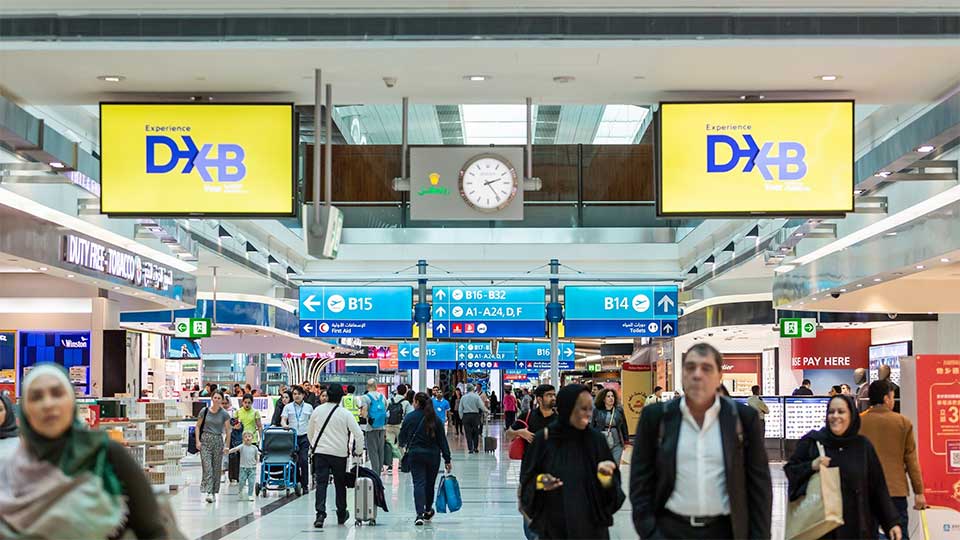
Dubai International Airport (DXB) has once again proven its dominance in global aviation. During the first half of 2025, DXB welcomed a staggering 46 million international passengers, setting a new record and officially regaining its title as the world’s busiest international airport. The airport not only surpassed pre-pandemic traffic levels but also strengthened its position as a central hub for international connectivity.
India Drives Growth at Dubai Airport in 2025
India emerged as the top contributor to this remarkable growth. With millions of travelers flying between India and Dubai for business, leisure, and family visits, the subcontinent became DXB’s largest international market in the first half of the year.
According to Dubai Airports CEO Paul Griffiths, “The strong performance from India reflects both the cultural and economic ties between our two nations. Demand for flights to and from India has been consistent and resilient.”
In total, India accounted for over 6.5 million passengers, followed by Saudi Arabia, the UK, and Pakistan as other major source markets.
Airlines Expand Capacity to Meet Dubai Airport Demand
Airlines operating at DXB responded swiftly to the surge. Emirates, Flydubai, and Air India expanded their schedules and added new routes to underserved Indian cities like Surat, Bhubaneswar, and Amritsar. These new routes opened up access to regional hubs and helped balance the passenger load across the airport’s terminals.
Moreover, several international carriers, including British Airways and Lufthansa, increased their frequency to Dubai to meet growing transit demand from Europe and North America.
By H1 2025, DXB handled an average of 256,000 passengers per day, with the summer travel season contributing significantly to peak traffic in June.
Transit Traffic Powers Dubai Airport’s Global Connectivity
Dubai’s strategic location between East and West continues to give DXB a major advantage. The airport functions as a primary transit hub connecting Europe, Asia, Africa, and the Americas.
Transit traffic—especially from Asia to Europe and vice versa—drove much of the passenger volume. Many travelers preferred DXB over other hubs due to its streamlined transfer experience, wide selection of dining and shopping options, and on-time performance.
Dubai Airports reported that transit passengers made up 37% of total traffic, while the remaining 63% comprised origin and destination travelers. This balance indicates DXB’s dual appeal as both a hub and a destination.
Dubai Airport Terminal 3 Enhances Operational Efficiency
Terminal 3, which serves exclusively for Emirates flights, processed nearly 65% of the airport’s traffic. The terminal’s smart systems and biometric boarding features reduced wait times and streamlined passenger flow during peak periods.
Dubai Airports has also invested in AI-powered predictive analytics and real-time baggage tracking, resulting in a 30% reduction in mishandled bags compared to the same period last year.
New digital wayfinding systems, interactive airport maps, and contactless check-in kiosks further enhanced the passenger experience.
Sustainability Efforts Strengthen Dubai Airport’s Green Profile
Even with this record-breaking passenger count, DXB maintained its commitment to sustainability. The airport has implemented several green initiatives, including:
- LED lighting upgrades across terminals
- Smart HVAC systems to reduce energy usage
- Water recycling stations and plastic bottle collection programs
Dubai Airports aims to reduce its carbon footprint by 20% by the end of 2025. Officials confirmed that the airport has already achieved over 13% energy savings during H1 2025.
Dubai Airport Sees Rising Cargo and Freight Activity
While passenger traffic has received most of the spotlight, cargo volumes also increased by 6% year-on-year. Dubai continues to serve as a critical hub for pharmaceuticals, electronics, and perishable goods flowing between Asia, Europe, and Africa.
In fact, Dubai World Central (DWC)—the city’s second airport—saw a corresponding rise in freight activity. However, DXB remains the primary driver of Dubai’s overall aviation performance.
Tourism Booms as Dubai Airport Breaks Passenger Records
The record passenger traffic has had a direct positive impact on Dubai’s tourism and hospitality industry. Hotels across the city reported average occupancy rates of 81%, with luxury properties near Downtown and Palm Jumeirah performing exceptionally well.
Popular attractions such as the Museum of the Future, Dubai Mall, and Burj Khalifa saw increased visitor numbers. Retail spending at DXB itself surged by 18%, fueled by duty-free shopping and F&B outlets.
Dubai’s Department of Economy and Tourism praised the synergy between aviation and tourism, noting that this traffic milestone plays a central role in achieving Dubai’s goal of welcoming 25 million tourists annually.
Dubai Airport Expansion Plans for H2 2025 Underway
Looking ahead, Dubai International Airport plans to enhance its capacity further. Runway refurbishment and new gate installations are underway to prepare for the upcoming winter travel season.
Dubai Airports projects total passenger numbers for 2025 may exceed 91 million, potentially surpassing the record set in 2019. To support this growth, authorities are evaluating upgrades to Terminal 2 and investing in new airside infrastructure.
Additionally, Emirates and Flydubai have announced fleet expansions and plan to launch new services to Africa and Eastern Europe.
Innovation and Strategy Keep Dubai Airport Ahead of Rivals
What sets DXB apart from other global hubs isn’t just its size. It’s the strategic foresight in infrastructure, partnerships, and innovation. The airport runs with seamless operations and smart passenger flow management. Its consistent investment in digital systems keeps it ahead of regional competitors like Doha (DOH) and Istanbul (IST).
By combining scale with efficiency, Dubai International Airport has built an ecosystem that supports global growth and passenger satisfaction simultaneously.
Dubai Airport Leads Global Recovery in 2025
Dubai International Airport’s achievement in H1 2025 goes beyond just numbers. It symbolizes the resilience of global travel, the strength of strategic investments, and the importance of market connectivity—especially with emerging economies like India.
As aviation continues its strong rebound, DXB stands as a blueprint for post-pandemic recovery and innovation. With more enhancements underway and an eye toward 100 million passengers per year, Dubai is not just chasing records—it’s defining the future of global air travel.







